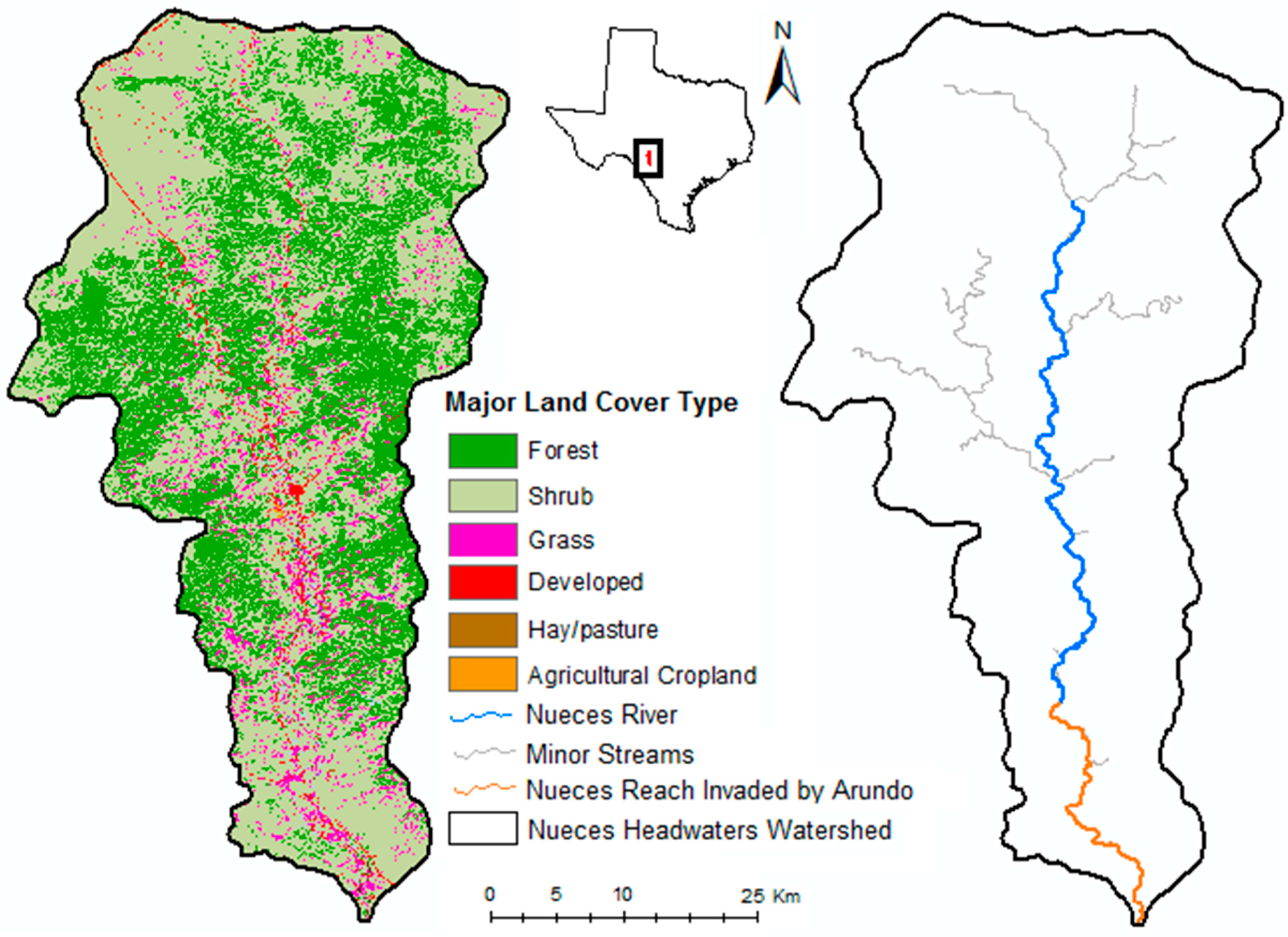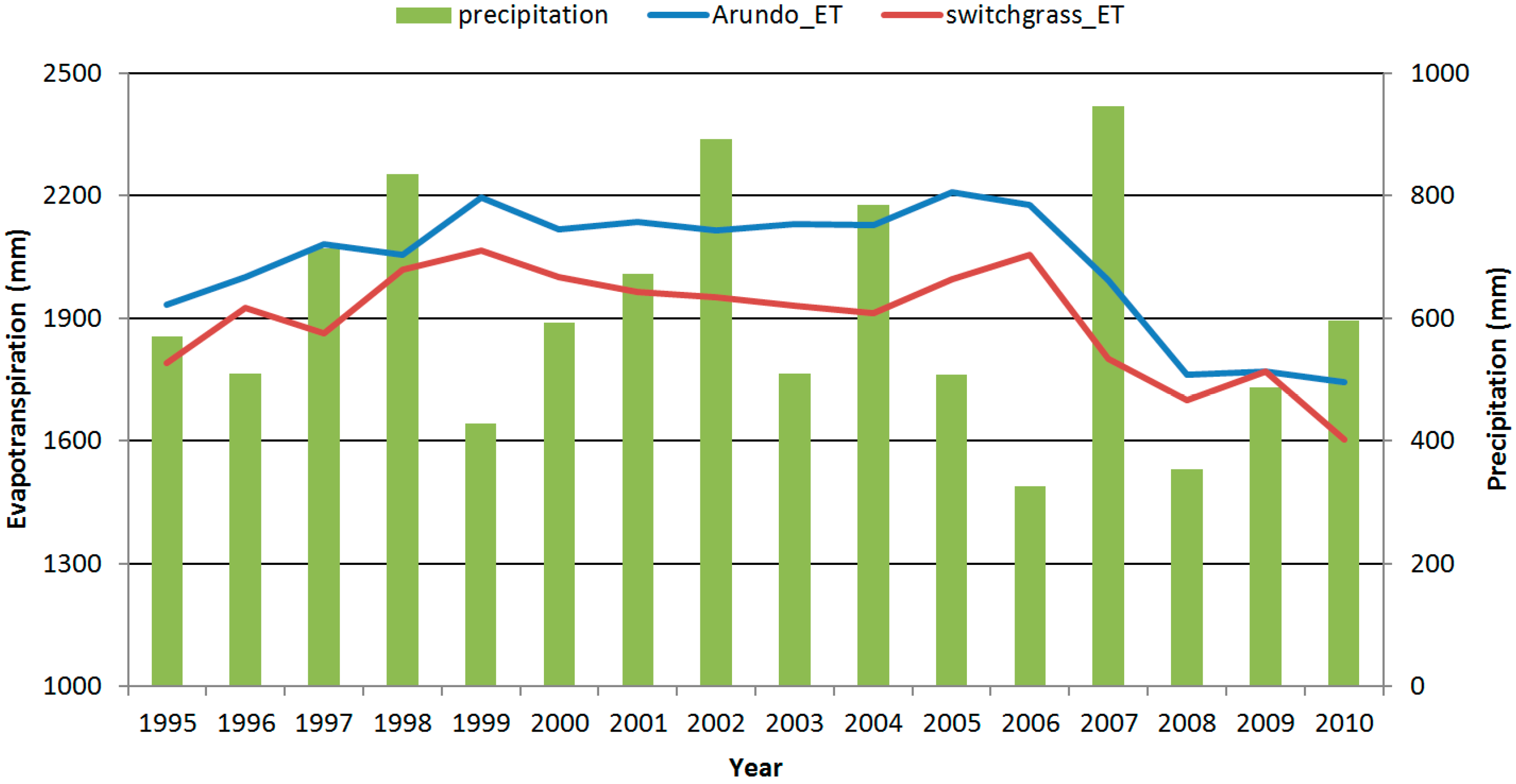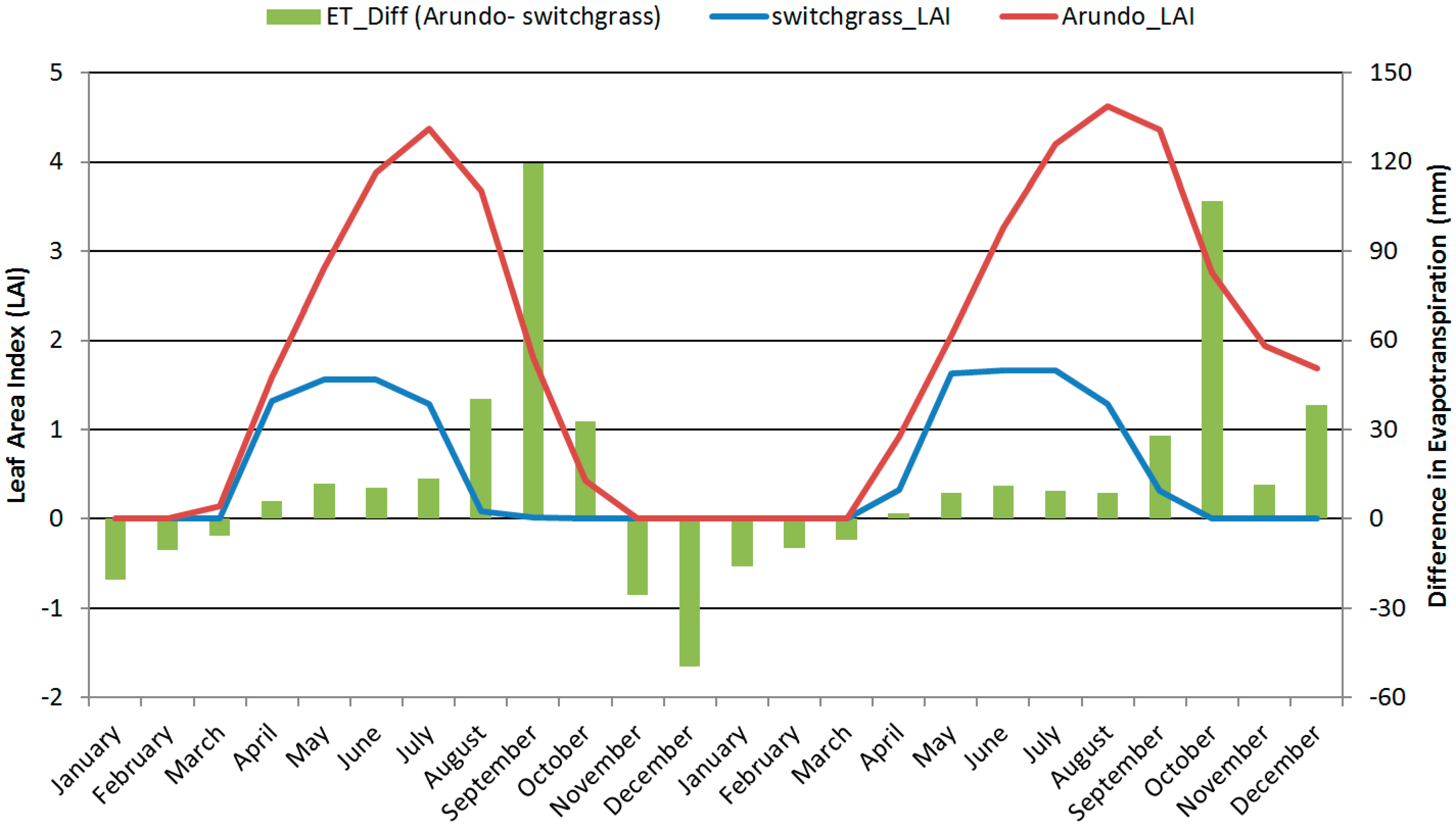Simulating the Hydrologic Impact of Arundo donax Invasion on the Headwaters of the Nueces River in Texas
Abstract
:1. Introduction
2. Methodology
2.1. Description of Study Area

2.2. Streamflow Analysis
2.3. Arundo Parametrization
| Parameter | Definition | Sugarcane | Arundo | Units |
|---|---|---|---|---|
| BIO_E (RUE) | Radiation-use efficiency or biomass-energy ratio | 25 | 45 | (kg/ha)/(MJ/m2) |
| BIOEHI | Biomass-energy ratio corresponding to the 2nd point on the radiation use efficiency curve | 33 | 52 | |
| BLAI | Maximum potential leaf area index | 6 | 12 | |
| FRGRW1 | Fraction of the plant growing season or fraction of total potential heat units corresponding to the 1st point on the optimal leaf area development curve | 0.15 | 0.1 | |
| LAIMX1 | Fraction of the maximum leaf area index corresponding to the 1st point on the optimal leaf area development curve | 0.01 | 0.2 | |
| DLAI | Fraction of growing season when leaf area begins to decline | 0.9 | 0.95 | |
| CHTMX | Maximum canopy height | 3 | 3.6 | m |
| T_base | Minimum (base) temperature for plant growth | 11 | 10 | °C |
| HVSTI | Harvest index for optimal growing conditions | 0.5 | 0.9 | |
| WSYF | Lower limit of harvest index | 0.01 | 0.15 | (kg/ha)/(kg/ha) |
| CNYLD | Normal fraction of nitrogen in yield | 0 | 0.0069 | kg N/kg yield |
| CPYLD | Normal fraction of phosphorus in yield | 0 | 0.0017 | kg P/kg yield |
| GSI | Maximum stomatal conductance at high solar radiation and low vapor pressure deficit | 0.0055 | 0.007 | m/s |
| EXT_COEF | Light extinction coefficient | - | 0.65 |
2.4. Setting up the SWAT Model
2.5. Model Calibration and Validation
| Parameter | Default Values | Calibrated Values |
|---|---|---|
| Subbasins with No Flow | ||
| ALPHA_BF | 0.048 | 0.9–1.0 |
| GW_DELAY | 31 days | 1 day |
| SOL_K | Default | +15% |
| CH_K2 | 0 | 250 mm/h |
| RCHRG_DP | Default | +0.2 |
| GWQMN | 0 | 5 mm |
| Subbasins with Springs | ||
| ALPHA_BF | 0.048 | 0.015 |
| GW_DELAY | 31 days | 218 days |
| SOL_K | Default | −30% |
| Subbasins without Springs and Sinkholes | ||
| ALPHA_BF | 0.048 | 0.015 |
| GW_DELAY | 31 | 218 days |
| SOL_K | Default | −20% |
| CH_K2 | 0 | 50 mm/h |
| All Subbasins | ||
| CN2 | Default | −15% |
| ESCO | Default | −0.1 |
| SOL_AWC | Default | +0.1 |
2.6. Scenario Analysis
3. Results and Discussion
3.1. Streamflow Trend Analysis
3.2. Model Calibration and Validation Results
3.3. Water Balances—Arundo vs. Switchgrass Scenarios



4. Conclusions
Acknowledgments
Author Contributions
Conflict of Interest
References
- Perdue, R.E., Jr. Arundo donax: Source of musical reeds and industrial cellulose. Econ. Bot. 1958, 12, 368–404. [Google Scholar] [CrossRef]
- McGaugh, S.; Hendrickson, D.; Bell, G.; Cabral, H.; Lyons, K.; McEachron, L.; Munoz, O. Fighting an aggressive wetlands invader: A case study of giant reed (Arundo donax) and its threat to Cuatro Ciénegas, Coahuila, Mexico. In Studies of North American Desert Fishes in Honor of EP (Phil) Pister, Conservationist; Lozano-Vilano, M.D.L., Contreras-Balderas, A.J., Eds.; Universidad Autónoma de Nuevo León, Facultad de Ciencias Biológicas: Monterrey, Nuevo León, México, 2006. [Google Scholar]
- Bell, G.P. Ecology and management of Arundo donax, and approaches to riparian habitat restoration in Southern California. In Plant Invasions. Studies from North America and Europe; Brock, J.H., Wade, M., Pyšek, P., Green, D., Eds.; Backhuys Publishers: Leiden, The Netherlands, 1998; pp. 103–113. [Google Scholar]
- Gowda, P.H.; Goolsby, J.A.; Yang, C.; Basu, S.; Racelis, A.; Howell, T.A. Estimating water use by giant reed along the Rio Grande using a large aperture scintillometer. Subtrop. Plant Sci. 2011, 63, 1–6. [Google Scholar]
- Watts, D.A.; Moore, G.W. Water-use dynamics of an invasive reed, Arundo donax, from leaf to stand. Wetlands 2011, 31, 725–734. [Google Scholar] [CrossRef]
- Giessow, J.; Casanova, J.; MacArthur, R.; Leclerc, R.; Fleming, G. Arundo donax Distribution and Impact Report; 06-374-559-0; California Invasive Plant Council (Cal-IPC): Berkeley, CA, USA, 2011. [Google Scholar]
- Benton, N.; Bell, G.; Swearingen, J.M. Fact Sheet: Giant Reed. Available online: http://www.nps.gov/plants/alien/fact/ardo1.htm (accessed on 10 January 2013).
- Zahran, M.A.; Willis, A.J. The Vegetation of Egypt, 2nd ed.; Springer Science & Business Media: Heidelberg, Baden-Württemberg, Germany, 2008. [Google Scholar]
- Dudley, T.L. Arundo Donax L. In Invasive Plants of California’s Wildlands, 1st ed.; Bossard, C.C., Randall, J.M., Hoshovsky, M.C., Eds.; University of California Press: Oakland, CA, USA, 2000; pp. 53–58. [Google Scholar]
- Goolsby, J.; Moran, P.; Kirk, A.; Jones, W.; Everitt, J.; Yang, C.; Parker, P.; Flores, D.; Spencer, D.; Pepper, A. Arundo donax-giant reed, an invasive weed of the Rio Grande Basin. In Proceedings of the Weed Science Society Annual Meeting, Champaign, IL, USA, June 2007.
- Snyder, K.A.; Scott, R.L.; McGwire, K. Multiple year effects of a biological control agent (Diorhabda carinulata) on Tamarix (saltcedar) ecosystem exchanges of carbon dioxide and water. Agric. For. Meteorol. 2012, 164, 161–169. [Google Scholar] [CrossRef]
- Sonnentag, O.; Detto, M.; Vargas, R.; Ryu, Y.; Runkle, B.R.K.; Kelly, M.; Baldocchi, D.D. Tracking the structural and functional development of a perennial pepperweed (Lepidium latifolium L.) infestation using a multi-year archive of webcam imagery and eddy covariance measurements. Agric. For. Meteorol. 2011, 151, 916–926. [Google Scholar] [CrossRef]
- Dzikiti, S.; Schachtschneider, K.; Naiken, V.; Gush, M.; Moses, G.; Le Maitre, D.C. Water relations and the effects of clearing invasive Prosopis trees on groundwater in an arid environment in the Northern Cape, South Africa. J. Arid Environ. 2013, 90, 103–113. [Google Scholar] [CrossRef]
- Porter, S.C. The Use of a Rainfall Simulator for Brush Control Research on the Edwards Plateau Region of Texas. Ph.D. Thesis, Texas A&M University, College Station, TX, USA, 2006. [Google Scholar]
- Tokumoto, L. Root Water Uptake and Soil Water Dynamics in a Karst Savanna on the Edwards Plateau, TX. Ph.D. Thesis, Texas A & M University, College Station, TX, USA, 2013. [Google Scholar]
- Wilcox, B.P.; Thurow, T.L. Emerging issues in rangeland ecohydrology: Vegetation change and the water cycle. Rangel. Ecol. Manag. 2006, 106, 261–289. [Google Scholar] [CrossRef]
- Arnold, J.G.; Srinivasan, R.; Muttiah, R.S.; Williams, J.R. Large area hydrologic modeling and assessment part I: Model development. J. Am. Water Resour. Assoc. 1998, 34, 73–89. [Google Scholar] [CrossRef]
- Arnold, J.G.; Allen, P.M.; Bernhardt, G. A comprehensive surface-groundwater flow model. J. Hydrol. 1993, 142, 47–69. [Google Scholar] [CrossRef]
- Bicknell, B.R.; Imhoff, J.C.; Kittle, J.L., Jr.; Donigian, A.S., Jr.; Johanson, R.C. Hydrological Simulation Program—Fortran: User’s Manual for Version 11; US Environmental Protection Agency, National Exposure Research Laboratory: Athens, GA, USA, 1997.
- Krysanova, V.; Müller-Wohlfeil, D.; Becker, A. Development and test of a spatially distributed hydrological/water quality model for mesoscale watersheds. Ecol. Model. 1998, 106, 261–289. [Google Scholar] [CrossRef]
- Borah, D.; Bera, M.; Xia, R. Storm event flow and sediment simulations in agricultural watersheds using DWSM. Trans. ASAE 2004, 47, 1539–1559. [Google Scholar] [CrossRef]
- Borah, D.K.; Bera, M. Watershed-scale hydrologic and nonpoint-source pollution models: Review of applications. Trans. ASAE 2004, 47, 789–803. [Google Scholar] [CrossRef]
- Arnold, J.G.; Moriasi, D.N.; Gassman, P.W.; Abbaspour, K.C.; White, M.J.; Srinivasan, R.; Santhi, C.; Harmel, R.D.; Griensven, A.V.; VanLiew, M.W.; et al. SWAT: Model use, calibration, and validation. Trans. ASABE 2012, 55, 1491–1508. [Google Scholar] [CrossRef]
- Afinowicz, J.D.; Munster, C.L.; Wilcox, B.P. Modeling effects of brush management on the rangeland water budget: Edwards plateau, Texas. J. Am. Water Resour. Assoc. 2005, 41, 181–193. [Google Scholar] [CrossRef]
- Bednarz, S.T.; Dybala, T.; Amonett, C.; Muttiah, R.S.; Rosenthal, W.; Srinivasan, R.; Arnold, J.G. Brush Management/Water Yield Feasibility Study for Four Watersheds in Texas; Texas Water Resources Institute: College Station, TX, USA, 2003. [Google Scholar]
- Qiao, L.; Zou, C.B.; Will, R.E.; Stebler, E. Calibration of SWAT model for woody plant encroachment using paired experimental watershed data. J. Hydrol. 2015, 523, 231–239. [Google Scholar] [CrossRef]
- Banta, R.J.; Lambert, R.B.; Slattery, R.N.; Ockerman, D.J. Streamflow Gain and Loss and Water Quality in the Upper Nueces River Basin, South-Central, Texas, 2008-10. Available online: http://pubs.usgs.gov/sir/2012/5181/ (accessed on 17 August 2015).
- Lim, K.J.; Engel, B.A.; Tang, Z.; Choi, J.; Kim, K.; Muthukrishnan, S.; Tripathy, D. Automated Web GIS Based Hydrograph Analysis Tool, WHAT. J. Am. Water Resour. Assoc. 2005, 41, 1407–1416. [Google Scholar] [CrossRef]
- Wilcox, B.P.; Huang, Y.; Walker, J.W. Long-term trends in streamflow from semiarid rangelands: Uncovering drivers of change. Glob. Chang. Biol. 2008, 14, 1676–1689. [Google Scholar] [CrossRef]
- Durbin, J.; Watson, G.S. Testing for serial correlation in Least Squares Regression: III. Biometrika 1971, 58, 1–19. [Google Scholar] [CrossRef]
- Kendall, M.G.; Gibbons, J.D. Rank Correlation Methods, 5th ed.; Oxford University Press: New York, NY, USA, 1990. [Google Scholar]
- Mann, H.B. Nonparametric tests against trend. Economterica 1945, 13, 245–259. [Google Scholar] [CrossRef]
- Gilbert, R.O. Statistical Methods for Environmental Pollution Monitoring, 87th ed.; Van Nostrand Reinhold Co.: New York, NY, USA, 1987. [Google Scholar]
- Kiniry, J.R.; Williams, J.R.; Gassman, P.W.; Debaeke, P. A general process-oriented model for two competing plant species. Trans. ASAE 1992, 35, 801–810. [Google Scholar] [CrossRef]
- Kiniry, J.R.; USDA-ARS Grassland, Soil and Water Research Laboratory, Temple, TX, USA. Field measurements of Arundo donax at Temple, TX, USA. Unpublished Data. 2010. [Google Scholar]
- National Hydrography Database. Available online: http://nhd.usgs.gov/data.html (accessed on 13 October 2013).
- Fry, J.A.; Dewitz, J.A.; Homer, C.G.; Xian, G.; Jin, S.; Yang, L.; Barnes, C.A.; Herold, N.D.; Wickham, J.D. Completion of the 2006 national land cover database for the conterminous United States. Photogramm. Eng. Remote Sens. 2011, 77, 858–864. [Google Scholar]
- Climatic Data for the United States. Available online: http://ars.usda.gov/Research/docs.htm?docid=19388 (accessed on 6 June 2014).
- Arnold, J.G.; Allen, P.M.; Muttiah, R.; Bernhardt, G. Automated base flow separation and recession analysis techniques. Ground Water 1995, 33, 1010–1018. [Google Scholar] [CrossRef]
- Baffaut, C.; Benson, V.W. Modeling flow and pollutant transport in a karst watershed with SWAT. Trans. ASABE 2009, 52, 469–479. [Google Scholar] [CrossRef]
- Echegaray, G.A. Modification of the SWAT Model to Simulate Hydrologic Processes in a Karst-influenced Watershed. Master’s Thesis, Virginia Polytechnic Institute and State University, Blacksburg, VA, USA, 2009. [Google Scholar]
- Nash, J.E.; Sutcliffe, J.V. River flow forecasting through conceptual models part I—A discussion of principles. J. Hydrol. 1970, 10, 282–290. [Google Scholar] [CrossRef]
- Gupta, H.V.; Sorooshian, S.; Yapo, P.O. Status of automatic calibration for hydrologic models: Comparison with multilevel expert calibration. J. Hydrol. Eng. 1999, 4, 135–143. [Google Scholar] [CrossRef]
- Pearson, E.S. Mathematical Statistics and Data Analysis, 2nd ed.; Duxbury: Belmont, CA, USA, 1938. [Google Scholar]
- Moriasi, D.; Arnold, J.; Van Liew, M.; Bingner, R.; Harmel, R.; Veith, T. Model evaluation guidelines for systematic quantification of accuracy in watershed simulations. Trans. ASABE 2007, 50, 885–900. [Google Scholar] [CrossRef]
- Spruill, C.; Workman, S.; Taraba, J. Simulation of daily and monthly stream discharge from small watersheds using the SWAT model. Trans. ASAE 2000, 43, 1431–1439. [Google Scholar] [CrossRef]
- Zou, C.B.; Turton, D.J.; Will, R.E.; Engle, D.M.; Fuhlendorf, S.D. Alteration of hydrological processes and streamflow with juniper (Juniperus virginiana) encroachment in a mesic grassland catchment. Hydrol. Process. 2014, 28, 6173–6182. [Google Scholar] [CrossRef]
© 2015 by the authors; licensee MDPI, Basel, Switzerland. This article is an open access article distributed under the terms and conditions of the Creative Commons Attribution license (http://creativecommons.org/licenses/by/4.0/).
Share and Cite
Jain, S.; Ale, S.; Munster, C.L.; Ansley, R.J.; Kiniry, J.R. Simulating the Hydrologic Impact of Arundo donax Invasion on the Headwaters of the Nueces River in Texas. Hydrology 2015, 2, 134-147. https://doi.org/10.3390/hydrology2030134
Jain S, Ale S, Munster CL, Ansley RJ, Kiniry JR. Simulating the Hydrologic Impact of Arundo donax Invasion on the Headwaters of the Nueces River in Texas. Hydrology. 2015; 2(3):134-147. https://doi.org/10.3390/hydrology2030134
Chicago/Turabian StyleJain, Shailee, Srinivasulu Ale, Clyde L. Munster, R. James Ansley, and James R. Kiniry. 2015. "Simulating the Hydrologic Impact of Arundo donax Invasion on the Headwaters of the Nueces River in Texas" Hydrology 2, no. 3: 134-147. https://doi.org/10.3390/hydrology2030134





